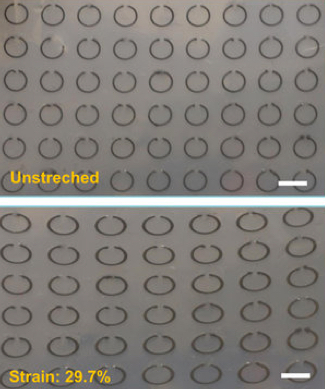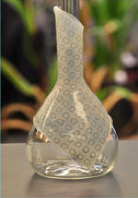Stretchable, flexible ‘meta-skin’ cloaks objects from radar at a range of frequencies
March 7, 2016

Flexible, stretchable, and frequency-tunable “meta-skin” can trap radar waves and cloak objects from radar detection (scale bars: 5 mm) (credit: Siming Yang et al./Scientific Reports)
Iowa State University engineers have developed a new flexible, stretchable, and tunable “meta-skin” (metamaterial) “invisibility cloak” that uses rows of small liquid-metal devices to cloak an object from radar over a wide range of frequencies — and possibly at visible or infrared light ranges in the future.

First wraparound meta-skin (credit: Siming Yang et al./Scientific Reports)
The skin has rows of split ring resonators embedded inside layers of silicone sheets. The resonators are filled with galinstan, a metal alloy that’s liquid at room temperature. That allows for stretching and flexing the polymer meta-skin, enabling it to be tuned to reduce reflection at a wide range of radar frequencies, unlike previous metamaterials.
Applications could include sub-wavelength imaging (of smaller objects), electromagnetic frequency tuning, shielding (from interference or detection), and scattering suppression (allowing a signal to be sent in specific directions rather than scattered).
Unlike conventional metamaterials, meta-skin can be conformed to curved and irregular surfaces.
The split-ring resonators used here are small rings with an outer radius of 2.5 millimeters and a thickness of half a millimeter. They have a 1 millimeter gap, essentially creating a small, curved segment of liquid wire.
The rings create electric inductors and the gaps create electric capacitors. Together they create a tuned resonator that can trap and suppress radar waves at a specific frequency. Stretching the meta-skin changes the size of the liquid metal rings inside and lowers the frequency the devices suppress.
Tests showed radar suppression was about 75 percent in the frequency range of 8 to 10 gigahertz in the experiment, according to the paper. When objects are wrapped in the meta-skin, the radar waves were suppressed in all incident directions and observation angles.
The open-access journal Scientific Reports recently reported the discovery online.
“The long-term goal is to shrink the size of these devices,” said senior author and associate professor Liang Dong, allowing for use with higher-frequency electromagnetic waves such as visible or infrared light. That would require advanced nanomanufacturing technologies and appropriate structural modifications, Dong noted.
The National Science Foundation and the China Scholarship Council partially supported the project.
Abstract of From Flexible and Stretchable Meta-Atom to Metamaterial: A Wearable Microwave Meta-Skin with Tunable Frequency Selective and Cloaking Effects
This paper reports a flexible and stretchable metamaterial-based “skin” or meta-skin with tunable frequency selective and cloaking effects in microwave frequency regime. The meta-skin is composed of an array of liquid metallic split ring resonators (SRRs) embedded in a stretchable elastomer. When stretched, the meta-skin performs as a tunable frequency selective surface with a wide resonance frequency tuning range. When wrapped around a curved dielectric material, the meta-skin functions as a flexible “cloaking” surface to significantly suppress scattering from the surface of the dielectric material along different directions. We studied frequency responses of multilayer meta-skins to stretching in a planar direction and to changing the spacing between neighboring layers in vertical direction. We also investigated scattering suppression effect of the meta-skin coated on a finite-length dielectric rod in free space. This meta-skin technology will benefit many electromagnetic applications, such as frequency tuning, shielding, and scattering suppression.